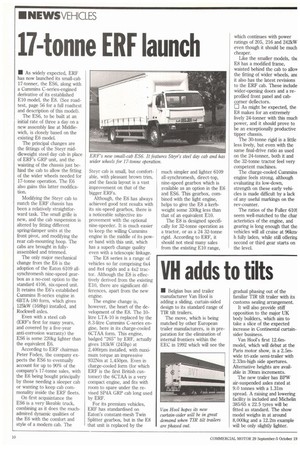11-tonne ERF launch
Page 8

If you've noticed an error in this article please click here to report it so we can fix it.
• As widely expected, ERF has now launched its small-cab 17-tonner, the ES6, along with a Cummins C-series-engined derivative of its established E 10 model, the E8. (See roadtest, page 56 for a full roadtest and description of this model).
The ES6, to be built at an initial rate of three a day on a new assembly line at Middlewich, is closely based on the existing E6 model.
The principal changes are the fittings of the Steyr middleweight steel day cab in place of ERF's GRP unit, and the waisting of the chassis just behind the cab to allow the fitting of the wider wheels needed for 17-tonne operation. The E6 also gains this latter modification.
Modifying the Steyr cab to match the ERF chassis has been a relatively straightforward task. The small grille is new, and the cab suspension is altered by fitting different spring/damper units at the front pivot, and modifying the rear cab-mounting hoop. The cabs are brought in fullyassembled and trimmed.
The only major mechanical change from the E6 is the adoption of the Eaton 6109 allsynchromesh nine-speed gearbox as a no-cost option to the standard 4106, six-speed unit. It retains the E6's established Cummins B-series engine in 6BTA-180 form, which gives 125kW (168hp) installed, and Rockwell axles.
Even with a steel cab (ERF's first for many years, and covered by a five-year anti-corrosion warranty) the ES6 is some 220kg lighter than the equivalent E6.
According to ERF chairman Peter Foden, the company expects the ES6 to eventually account for up to 90% of the company's 17-tonne sales, with the E6 being bought principally by those needing a sleeper cab or wanting to keep cab commonality inside the ERF fleets.
On first acquaintance the ES6 is a very likeable truck, combining as it does the muchadmired dynamic qualities of the E6 with the comfort and style of a modem cab. The Steyr cab is small, but comfortable, with pleasant brown trim, and the fascia layout is a vast improvement on that of the bigger ERFs.
Although, the E6 has always achieved good test results with its six-speed gearbox, there is a noticeable subjective improvement with the optional nine-speeder. It is much easier to keep the willing Cummins engine in the middle of its power band with this unit, which has a superb change quality even with a telescopic linkage.
The E8 series is a range of vehicles so far comprising 6x4 and 8x4 rigids and a 4x2 tractor. Although the E8 is effectively derived from the existing E10, there are significant differences, apart from the new engine.
The engine change is, however, the heart of the development of the E8. The 10litre LTA-10 is replaced by the 8.3-litre Cummins C-series engine, here in its charge-cooled 6CTAA form. This engine, badged "265" by ERF, actually gives 183kW (245hp) at 2,400rpm installed, with maximum torque an impressive 932Nm at 1,450pm. Even in charge-cooled form (for which ERF is the first British customer) the 6CTAA is a very compact engine, and fits with room to spare under the revised SP4A GRP cab long used by ERF.
For its premium vehicles, ERF has standardised on Eaton's constant-mesh Twin Splitter gearbox, but in the E8 that unit is replaced by the much simpler and lighter 6109 all-synchromesh, direct-top, nine-speed gearbox which is available as an option in the E6 and ES6. This gearbox, combined with the light engine, helps to give the E8 a kerbweight some 330kg less than that of an equivalent E10.
The E8 is designed specifically for 32-tonne operation as a tractor, or as a 24 32-tonne rigid. According to ERF, it should not steal many sales from the existing EN range, which continues with power ratings of 205, 216 and 242kW even though it should be much cheaper.
Like the smaller models, the E8 has a modified frame, waisted behind the cab to alloy the fitting of wider wheels, an( it also has the latest revisions to the ERF cab. These include wider-opening doors and a reprofiled front panel and cabcorner deflectors.
0 As might be expected, the E8 makes for an extremely lively 24-tonner with this much power, and it should prove to be an exceptionally productive tipper chassis.
The 30-tonne rigid is a little less lively, but even with the same final-drive ratio as used on the 24-tonner, both it and the 32-tonne tractor feel very competent machines.
The charge-cooled Cummins engine feels strong, although evaluating its low-down, strength on these early vehides is made difficult by a lack of any useful markings on the rev-counter.
The ratios of the Fuller 610c. seem well-matched to the char acteristics of the engine, and gearing is long enough that the vehicles will all cruise at 96Iuni h fully laden, while still offering second or third gear starts on the level.
















































